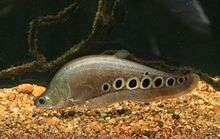Notopteridae
The family Notopteridae contains ten species of osteoglossiform (bony-tongued) fishes, commonly known as featherbacks and knifefishes. These fishes live in freshwater or brackish environments in Africa, and South and Southeast Asia.
| Featherbacks | |
|---|---|
 | |
| Chitala ornata | |
| Scientific classification | |
| Kingdom: | |
| Phylum: | |
| Class: | |
| Order: | |
| Family: | Notopteridae Bleeker, 1859 |
| Genera | |
|
see text | |
With the denotation of "knifefish", the Notopterids should not be confused with Gymnotiformes, the electric knifefishes from South and Central America. Although their manner of swimming is similar and they are superficially similar in appearance, the two groups are not closely related.
A few of the larger species, especially Chitala ornata, are food fish and occasionally aquarium pets. The name is from Greek noton meaning "back" and pteron meaning "fin".
Description
Featherbacks have slender, elongated, bodies, giving them a knife-like appearance. The caudal fin is small and fused with the anal fin, which runs most of the length of the body. Where present, the dorsal fin is small and narrow, giving rise to the common name of "featherback". The fish swims by holding its body rigid and rippling the anal fin to propel itself forward or backwards.[1]
Notopterids have specialized swim bladders. The organ extends throughout the body and even into the fins in some cases. Although the swim bladder is not highly vascularised, it can absorb oxygen from air and also functions to produce sound by squeezing air through a narrow passage into the pharynx.[1]
At least some species prepare nests and guard the eggs until they hatch.[1]
Species
The ten species in four genera are:[2]
- Genus †Notopteridarum Rana 1988 [otolith]
- †Notopteridarum nolfi Rana 1988 [otolith]
- Genus †Palaeonotopterus Forey 1997
- †Palaeonotopterus greenwoodi Forey 1997
- Subfamily Xenomystinae Greenwood 1963
- Subfamily Notopterinae Bleeker 1851 (Asian knifefishes; Featherbacks)
- Genus Chitala Fowler, 1934
- Chitala blanci (d'Aubenton, 1965) (royal knifefish or Indochina featherback)
- Chitala borneensis (Bleeker, 1851) (Indonesian featherback)
- Chitala chitala (F. Hamilton, 1822) (Indian featherback)
- Chitala hypselonotus (Bleeker, 1852)
- Chitala lopis (Bleeker, 1851) (giant featherback)
- Chitala ornata (J. E. Gray, 1831) (clown featherback or clown knifefish)
- Genus Notopterus Lacépède, 1800
- Notopterus notopterus (Pallas, 1769) (bronze featherback)
- Genus Papyrocranus Greenwood, 1963
- Papyrocranus afer (Günther, 1868) (reticulated knifefish)
- Papyrocranus congoensis (Nichols & La Monte, 1932)
- Genus Chitala Fowler, 1934
References
- Greenwood, P. H. & Wilson, M. V. (1998). Paxton, J. R. & Eschmeyer, W. N. (eds.). Encyclopedia of Fishes. San Diego: Academic Press. pp. 82–83. ISBN 0-12-547665-5.
- Haaramo, Mikko (2007). "Osteoglossomorpha – bony-tongue fishes and relatives". Mikko's Phylogeny Archive. Retrieved 30 December 2016.
- Berra, Tim M. (2001). Freshwater Fish Distribution. San Diego: Academic Press. ISBN 0-12-093156-7
- Froese, Rainer, and Daniel Pauly, eds. (2011). "Notopteridae" in FishBase. June 2011 version.
- The historical biogeography of the freshwater knifefishes.